Consumer Behaviour Analysis: Decision Making in Marketing Report
VerifiedAdded on 2023/01/06
|10
|4124
|25
Report
AI Summary
This report provides a comprehensive analysis of consumer behavior, focusing on the stages of the consumer decision-making process, from problem recognition to post-purchase evaluation. It explores how marketers respond to consumer choices at each stage and emphasizes the importance of mapping a path to purchase. The report compares and contrasts the decision-making processes in B2B and B2C contexts, highlighting key differences and similarities. It also evaluates various market research approaches and discusses how different marketing strategies, including relationship marketing, influence consumer decisions. The study examines factors such as promotions, customer service, and the role of online information in shaping consumer behavior.
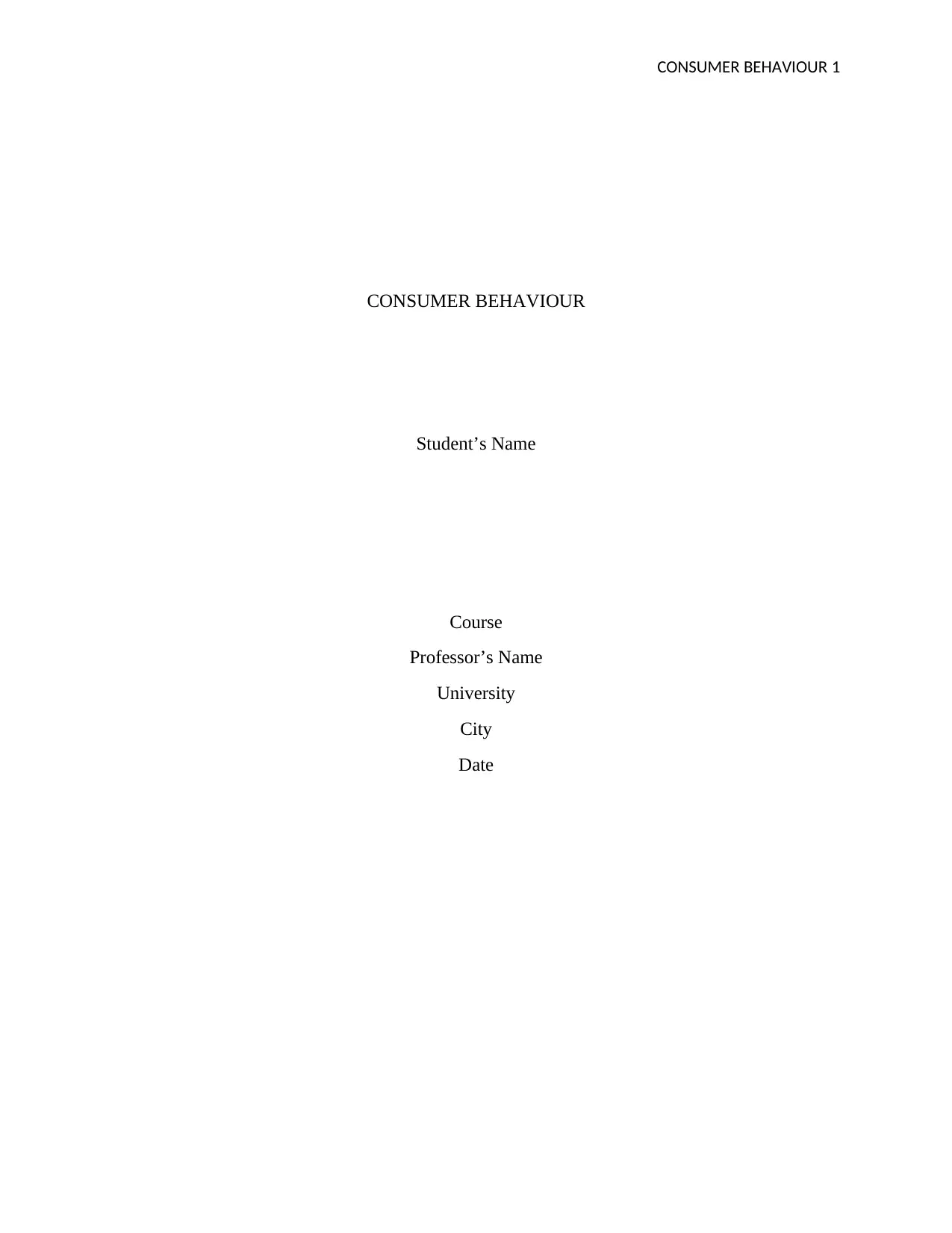
CONSUMER BEHAVIOUR 1
CONSUMER BEHAVIOUR
Student’s Name
Course
Professor’s Name
University
City
Date
CONSUMER BEHAVIOUR
Student’s Name
Course
Professor’s Name
University
City
Date
Paraphrase This Document
Need a fresh take? Get an instant paraphrase of this document with our AI Paraphraser
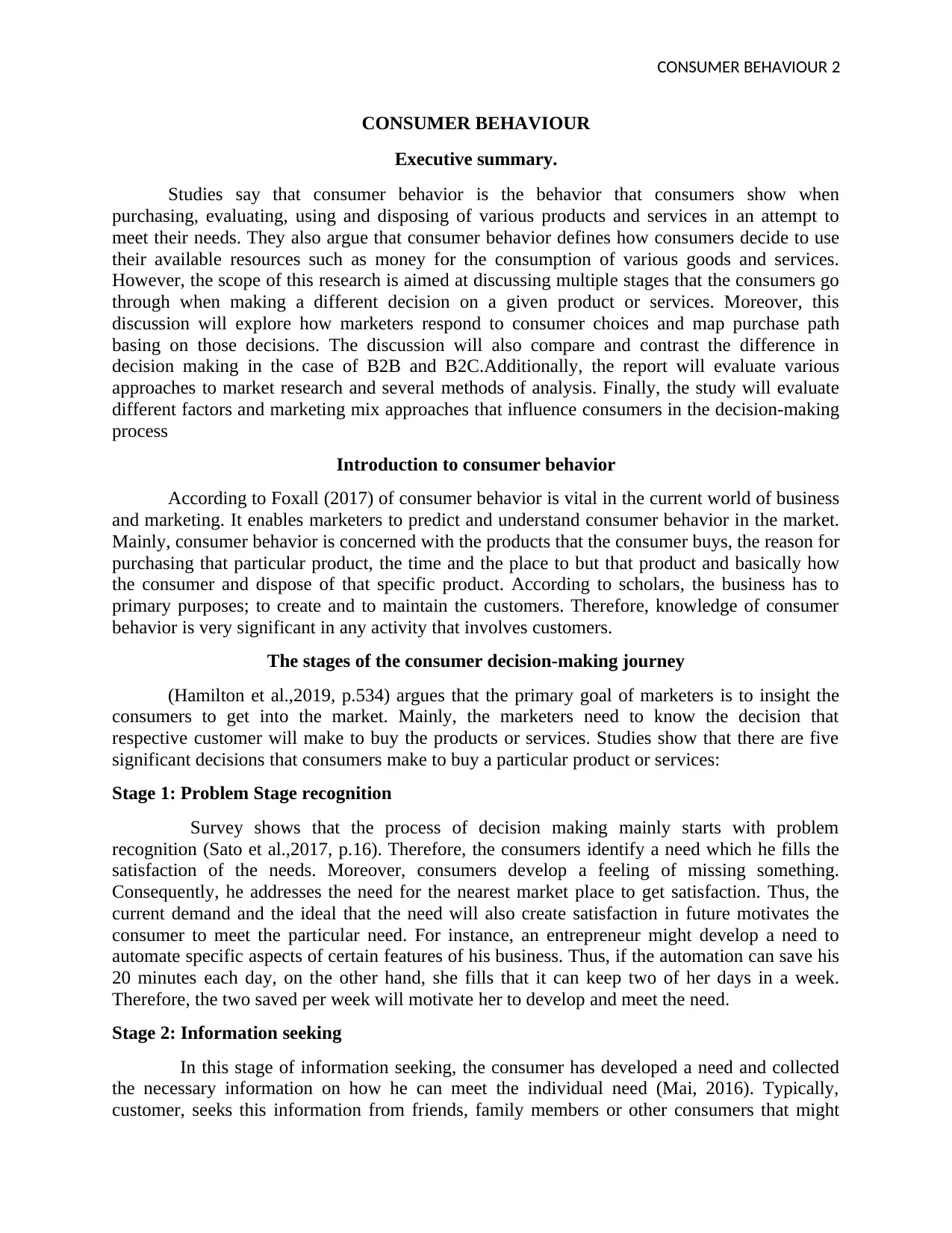
CONSUMER BEHAVIOUR 2
CONSUMER BEHAVIOUR
Executive summary.
Studies say that consumer behavior is the behavior that consumers show when
purchasing, evaluating, using and disposing of various products and services in an attempt to
meet their needs. They also argue that consumer behavior defines how consumers decide to use
their available resources such as money for the consumption of various goods and services.
However, the scope of this research is aimed at discussing multiple stages that the consumers go
through when making a different decision on a given product or services. Moreover, this
discussion will explore how marketers respond to consumer choices and map purchase path
basing on those decisions. The discussion will also compare and contrast the difference in
decision making in the case of B2B and B2C.Additionally, the report will evaluate various
approaches to market research and several methods of analysis. Finally, the study will evaluate
different factors and marketing mix approaches that influence consumers in the decision-making
process
Introduction to consumer behavior
According to Foxall (2017) of consumer behavior is vital in the current world of business
and marketing. It enables marketers to predict and understand consumer behavior in the market.
Mainly, consumer behavior is concerned with the products that the consumer buys, the reason for
purchasing that particular product, the time and the place to but that product and basically how
the consumer and dispose of that specific product. According to scholars, the business has to
primary purposes; to create and to maintain the customers. Therefore, knowledge of consumer
behavior is very significant in any activity that involves customers.
The stages of the consumer decision-making journey
(Hamilton et al.,2019, p.534) argues that the primary goal of marketers is to insight the
consumers to get into the market. Mainly, the marketers need to know the decision that
respective customer will make to buy the products or services. Studies show that there are five
significant decisions that consumers make to buy a particular product or services:
Stage 1: Problem Stage recognition
Survey shows that the process of decision making mainly starts with problem
recognition (Sato et al.,2017, p.16). Therefore, the consumers identify a need which he fills the
satisfaction of the needs. Moreover, consumers develop a feeling of missing something.
Consequently, he addresses the need for the nearest market place to get satisfaction. Thus, the
current demand and the ideal that the need will also create satisfaction in future motivates the
consumer to meet the particular need. For instance, an entrepreneur might develop a need to
automate specific aspects of certain features of his business. Thus, if the automation can save his
20 minutes each day, on the other hand, she fills that it can keep two of her days in a week.
Therefore, the two saved per week will motivate her to develop and meet the need.
Stage 2: Information seeking
In this stage of information seeking, the consumer has developed a need and collected
the necessary information on how he can meet the individual need (Mai, 2016). Typically,
customer, seeks this information from friends, family members or other consumers that might
CONSUMER BEHAVIOUR
Executive summary.
Studies say that consumer behavior is the behavior that consumers show when
purchasing, evaluating, using and disposing of various products and services in an attempt to
meet their needs. They also argue that consumer behavior defines how consumers decide to use
their available resources such as money for the consumption of various goods and services.
However, the scope of this research is aimed at discussing multiple stages that the consumers go
through when making a different decision on a given product or services. Moreover, this
discussion will explore how marketers respond to consumer choices and map purchase path
basing on those decisions. The discussion will also compare and contrast the difference in
decision making in the case of B2B and B2C.Additionally, the report will evaluate various
approaches to market research and several methods of analysis. Finally, the study will evaluate
different factors and marketing mix approaches that influence consumers in the decision-making
process
Introduction to consumer behavior
According to Foxall (2017) of consumer behavior is vital in the current world of business
and marketing. It enables marketers to predict and understand consumer behavior in the market.
Mainly, consumer behavior is concerned with the products that the consumer buys, the reason for
purchasing that particular product, the time and the place to but that product and basically how
the consumer and dispose of that specific product. According to scholars, the business has to
primary purposes; to create and to maintain the customers. Therefore, knowledge of consumer
behavior is very significant in any activity that involves customers.
The stages of the consumer decision-making journey
(Hamilton et al.,2019, p.534) argues that the primary goal of marketers is to insight the
consumers to get into the market. Mainly, the marketers need to know the decision that
respective customer will make to buy the products or services. Studies show that there are five
significant decisions that consumers make to buy a particular product or services:
Stage 1: Problem Stage recognition
Survey shows that the process of decision making mainly starts with problem
recognition (Sato et al.,2017, p.16). Therefore, the consumers identify a need which he fills the
satisfaction of the needs. Moreover, consumers develop a feeling of missing something.
Consequently, he addresses the need for the nearest market place to get satisfaction. Thus, the
current demand and the ideal that the need will also create satisfaction in future motivates the
consumer to meet the particular need. For instance, an entrepreneur might develop a need to
automate specific aspects of certain features of his business. Thus, if the automation can save his
20 minutes each day, on the other hand, she fills that it can keep two of her days in a week.
Therefore, the two saved per week will motivate her to develop and meet the need.
Stage 2: Information seeking
In this stage of information seeking, the consumer has developed a need and collected
the necessary information on how he can meet the individual need (Mai, 2016). Typically,
customer, seeks this information from friends, family members or other consumers that might
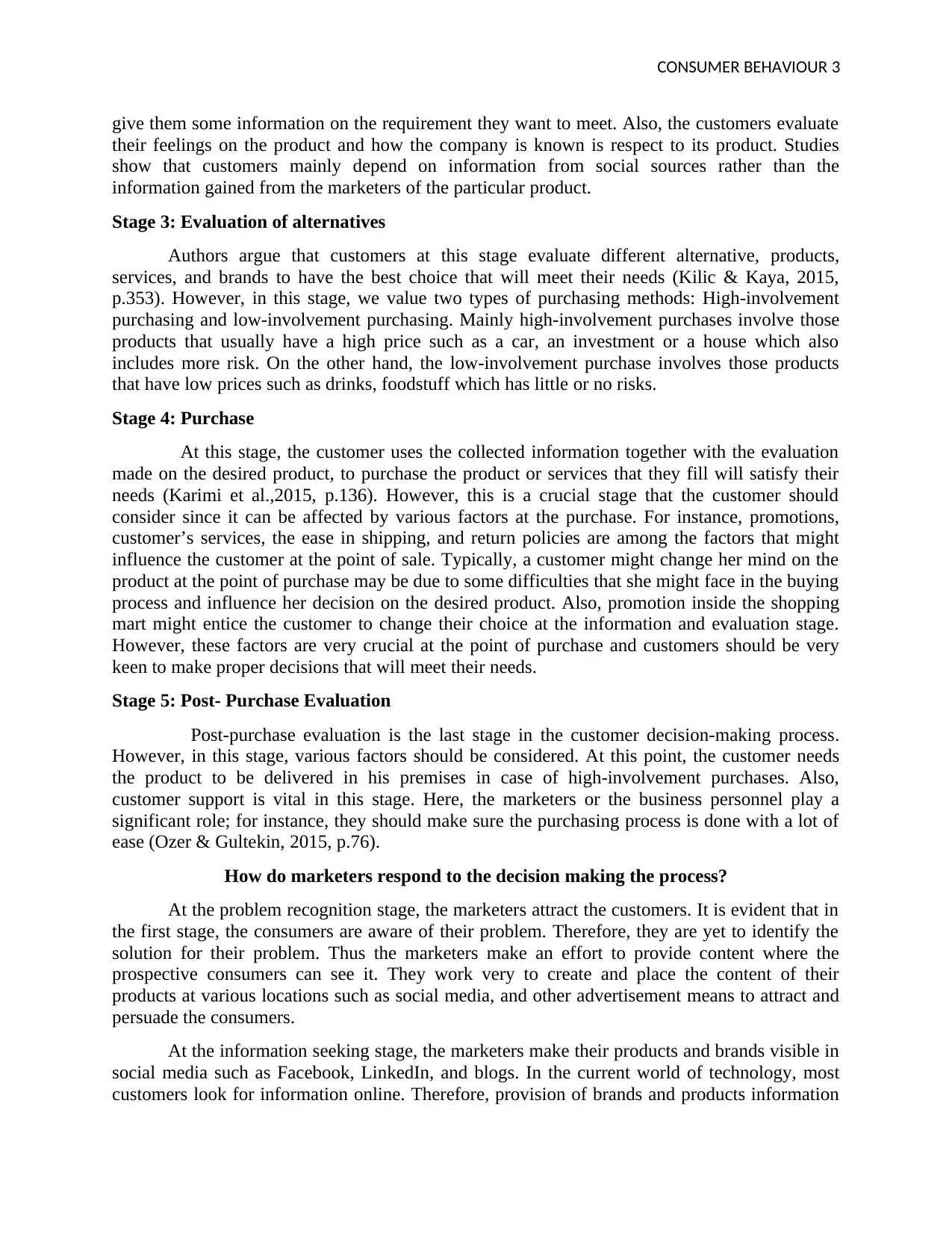
CONSUMER BEHAVIOUR 3
give them some information on the requirement they want to meet. Also, the customers evaluate
their feelings on the product and how the company is known is respect to its product. Studies
show that customers mainly depend on information from social sources rather than the
information gained from the marketers of the particular product.
Stage 3: Evaluation of alternatives
Authors argue that customers at this stage evaluate different alternative, products,
services, and brands to have the best choice that will meet their needs (Kilic & Kaya, 2015,
p.353). However, in this stage, we value two types of purchasing methods: High-involvement
purchasing and low-involvement purchasing. Mainly high-involvement purchases involve those
products that usually have a high price such as a car, an investment or a house which also
includes more risk. On the other hand, the low-involvement purchase involves those products
that have low prices such as drinks, foodstuff which has little or no risks.
Stage 4: Purchase
At this stage, the customer uses the collected information together with the evaluation
made on the desired product, to purchase the product or services that they fill will satisfy their
needs (Karimi et al.,2015, p.136). However, this is a crucial stage that the customer should
consider since it can be affected by various factors at the purchase. For instance, promotions,
customer’s services, the ease in shipping, and return policies are among the factors that might
influence the customer at the point of sale. Typically, a customer might change her mind on the
product at the point of purchase may be due to some difficulties that she might face in the buying
process and influence her decision on the desired product. Also, promotion inside the shopping
mart might entice the customer to change their choice at the information and evaluation stage.
However, these factors are very crucial at the point of purchase and customers should be very
keen to make proper decisions that will meet their needs.
Stage 5: Post- Purchase Evaluation
Post-purchase evaluation is the last stage in the customer decision-making process.
However, in this stage, various factors should be considered. At this point, the customer needs
the product to be delivered in his premises in case of high-involvement purchases. Also,
customer support is vital in this stage. Here, the marketers or the business personnel play a
significant role; for instance, they should make sure the purchasing process is done with a lot of
ease (Ozer & Gultekin, 2015, p.76).
How do marketers respond to the decision making the process?
At the problem recognition stage, the marketers attract the customers. It is evident that in
the first stage, the consumers are aware of their problem. Therefore, they are yet to identify the
solution for their problem. Thus the marketers make an effort to provide content where the
prospective consumers can see it. They work very to create and place the content of their
products at various locations such as social media, and other advertisement means to attract and
persuade the consumers.
At the information seeking stage, the marketers make their products and brands visible in
social media such as Facebook, LinkedIn, and blogs. In the current world of technology, most
customers look for information online. Therefore, provision of brands and products information
give them some information on the requirement they want to meet. Also, the customers evaluate
their feelings on the product and how the company is known is respect to its product. Studies
show that customers mainly depend on information from social sources rather than the
information gained from the marketers of the particular product.
Stage 3: Evaluation of alternatives
Authors argue that customers at this stage evaluate different alternative, products,
services, and brands to have the best choice that will meet their needs (Kilic & Kaya, 2015,
p.353). However, in this stage, we value two types of purchasing methods: High-involvement
purchasing and low-involvement purchasing. Mainly high-involvement purchases involve those
products that usually have a high price such as a car, an investment or a house which also
includes more risk. On the other hand, the low-involvement purchase involves those products
that have low prices such as drinks, foodstuff which has little or no risks.
Stage 4: Purchase
At this stage, the customer uses the collected information together with the evaluation
made on the desired product, to purchase the product or services that they fill will satisfy their
needs (Karimi et al.,2015, p.136). However, this is a crucial stage that the customer should
consider since it can be affected by various factors at the purchase. For instance, promotions,
customer’s services, the ease in shipping, and return policies are among the factors that might
influence the customer at the point of sale. Typically, a customer might change her mind on the
product at the point of purchase may be due to some difficulties that she might face in the buying
process and influence her decision on the desired product. Also, promotion inside the shopping
mart might entice the customer to change their choice at the information and evaluation stage.
However, these factors are very crucial at the point of purchase and customers should be very
keen to make proper decisions that will meet their needs.
Stage 5: Post- Purchase Evaluation
Post-purchase evaluation is the last stage in the customer decision-making process.
However, in this stage, various factors should be considered. At this point, the customer needs
the product to be delivered in his premises in case of high-involvement purchases. Also,
customer support is vital in this stage. Here, the marketers or the business personnel play a
significant role; for instance, they should make sure the purchasing process is done with a lot of
ease (Ozer & Gultekin, 2015, p.76).
How do marketers respond to the decision making the process?
At the problem recognition stage, the marketers attract the customers. It is evident that in
the first stage, the consumers are aware of their problem. Therefore, they are yet to identify the
solution for their problem. Thus the marketers make an effort to provide content where the
prospective consumers can see it. They work very to create and place the content of their
products at various locations such as social media, and other advertisement means to attract and
persuade the consumers.
At the information seeking stage, the marketers make their products and brands visible in
social media such as Facebook, LinkedIn, and blogs. In the current world of technology, most
customers look for information online. Therefore, provision of brands and products information
⊘ This is a preview!⊘
Do you want full access?
Subscribe today to unlock all pages.

Trusted by 1+ million students worldwide
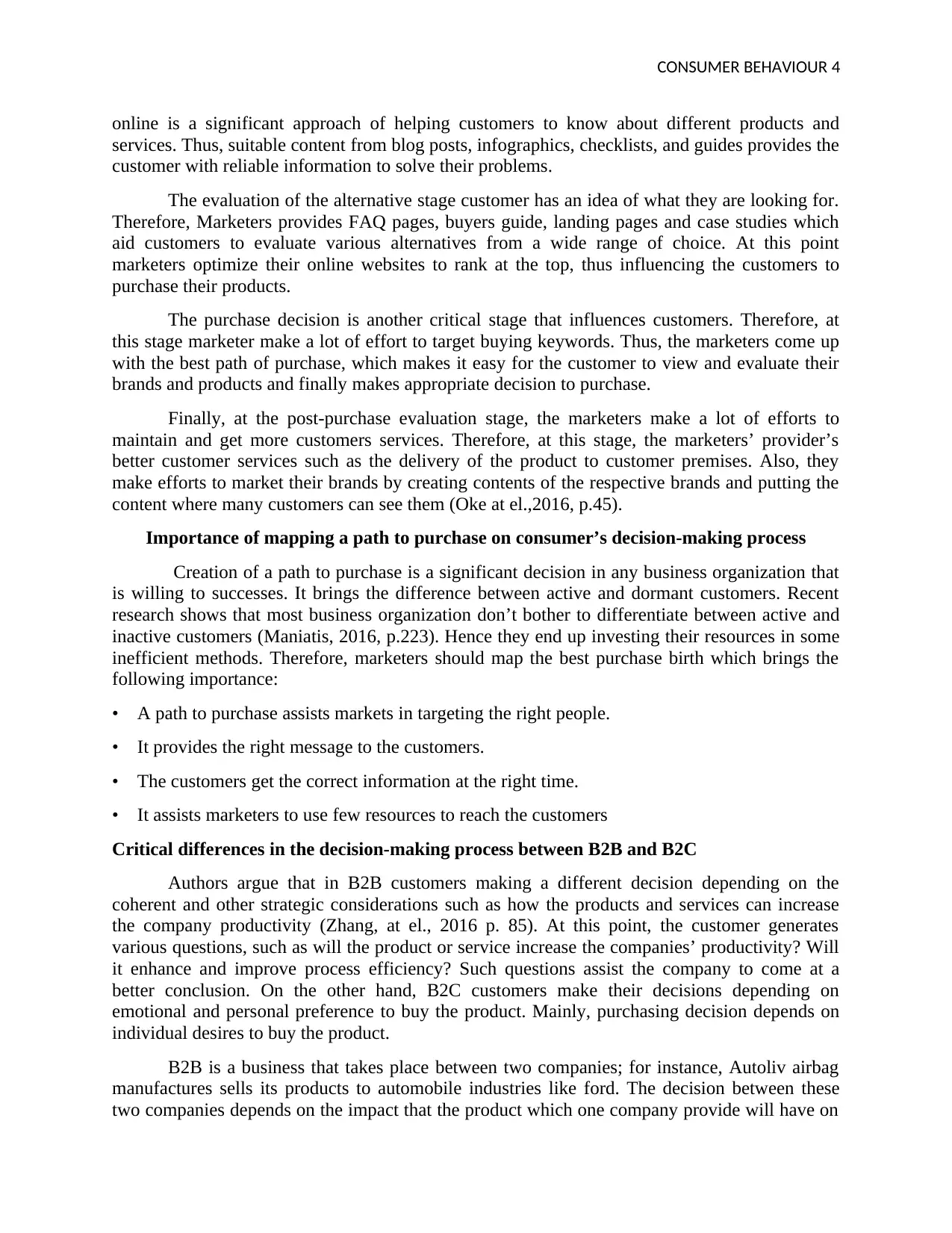
CONSUMER BEHAVIOUR 4
online is a significant approach of helping customers to know about different products and
services. Thus, suitable content from blog posts, infographics, checklists, and guides provides the
customer with reliable information to solve their problems.
The evaluation of the alternative stage customer has an idea of what they are looking for.
Therefore, Marketers provides FAQ pages, buyers guide, landing pages and case studies which
aid customers to evaluate various alternatives from a wide range of choice. At this point
marketers optimize their online websites to rank at the top, thus influencing the customers to
purchase their products.
The purchase decision is another critical stage that influences customers. Therefore, at
this stage marketer make a lot of effort to target buying keywords. Thus, the marketers come up
with the best path of purchase, which makes it easy for the customer to view and evaluate their
brands and products and finally makes appropriate decision to purchase.
Finally, at the post-purchase evaluation stage, the marketers make a lot of efforts to
maintain and get more customers services. Therefore, at this stage, the marketers’ provider’s
better customer services such as the delivery of the product to customer premises. Also, they
make efforts to market their brands by creating contents of the respective brands and putting the
content where many customers can see them (Oke at el.,2016, p.45).
Importance of mapping a path to purchase on consumer’s decision-making process
Creation of a path to purchase is a significant decision in any business organization that
is willing to successes. It brings the difference between active and dormant customers. Recent
research shows that most business organization don’t bother to differentiate between active and
inactive customers (Maniatis, 2016, p.223). Hence they end up investing their resources in some
inefficient methods. Therefore, marketers should map the best purchase birth which brings the
following importance:
• A path to purchase assists markets in targeting the right people.
• It provides the right message to the customers.
• The customers get the correct information at the right time.
• It assists marketers to use few resources to reach the customers
Critical differences in the decision-making process between B2B and B2C
Authors argue that in B2B customers making a different decision depending on the
coherent and other strategic considerations such as how the products and services can increase
the company productivity (Zhang, at el., 2016 p. 85). At this point, the customer generates
various questions, such as will the product or service increase the companies’ productivity? Will
it enhance and improve process efficiency? Such questions assist the company to come at a
better conclusion. On the other hand, B2C customers make their decisions depending on
emotional and personal preference to buy the product. Mainly, purchasing decision depends on
individual desires to buy the product.
B2B is a business that takes place between two companies; for instance, Autoliv airbag
manufactures sells its products to automobile industries like ford. The decision between these
two companies depends on the impact that the product which one company provide will have on
online is a significant approach of helping customers to know about different products and
services. Thus, suitable content from blog posts, infographics, checklists, and guides provides the
customer with reliable information to solve their problems.
The evaluation of the alternative stage customer has an idea of what they are looking for.
Therefore, Marketers provides FAQ pages, buyers guide, landing pages and case studies which
aid customers to evaluate various alternatives from a wide range of choice. At this point
marketers optimize their online websites to rank at the top, thus influencing the customers to
purchase their products.
The purchase decision is another critical stage that influences customers. Therefore, at
this stage marketer make a lot of effort to target buying keywords. Thus, the marketers come up
with the best path of purchase, which makes it easy for the customer to view and evaluate their
brands and products and finally makes appropriate decision to purchase.
Finally, at the post-purchase evaluation stage, the marketers make a lot of efforts to
maintain and get more customers services. Therefore, at this stage, the marketers’ provider’s
better customer services such as the delivery of the product to customer premises. Also, they
make efforts to market their brands by creating contents of the respective brands and putting the
content where many customers can see them (Oke at el.,2016, p.45).
Importance of mapping a path to purchase on consumer’s decision-making process
Creation of a path to purchase is a significant decision in any business organization that
is willing to successes. It brings the difference between active and dormant customers. Recent
research shows that most business organization don’t bother to differentiate between active and
inactive customers (Maniatis, 2016, p.223). Hence they end up investing their resources in some
inefficient methods. Therefore, marketers should map the best purchase birth which brings the
following importance:
• A path to purchase assists markets in targeting the right people.
• It provides the right message to the customers.
• The customers get the correct information at the right time.
• It assists marketers to use few resources to reach the customers
Critical differences in the decision-making process between B2B and B2C
Authors argue that in B2B customers making a different decision depending on the
coherent and other strategic considerations such as how the products and services can increase
the company productivity (Zhang, at el., 2016 p. 85). At this point, the customer generates
various questions, such as will the product or service increase the companies’ productivity? Will
it enhance and improve process efficiency? Such questions assist the company to come at a
better conclusion. On the other hand, B2C customers make their decisions depending on
emotional and personal preference to buy the product. Mainly, purchasing decision depends on
individual desires to buy the product.
B2B is a business that takes place between two companies; for instance, Autoliv airbag
manufactures sells its products to automobile industries like ford. The decision between these
two companies depends on the impact that the product which one company provide will have on
Paraphrase This Document
Need a fresh take? Get an instant paraphrase of this document with our AI Paraphraser
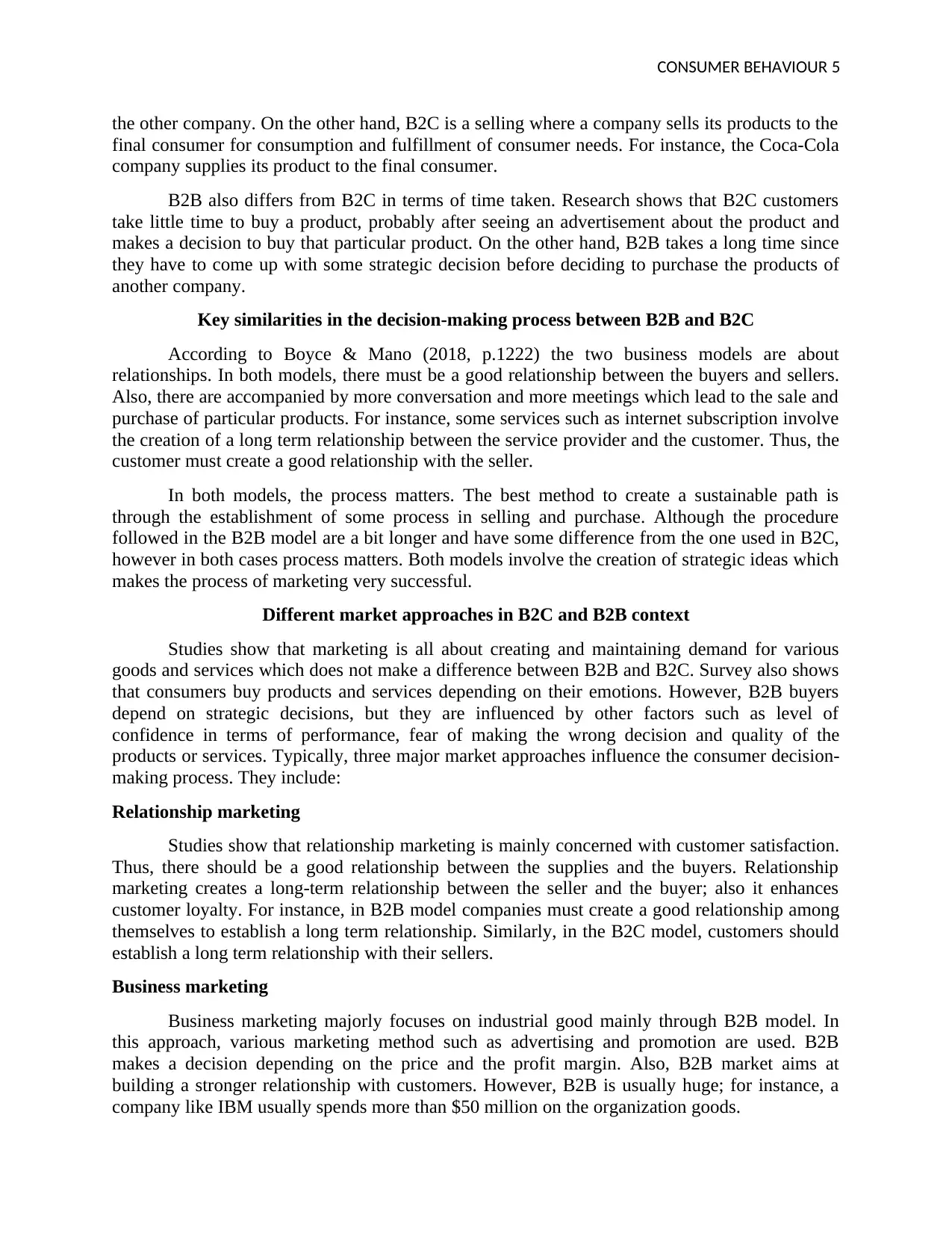
CONSUMER BEHAVIOUR 5
the other company. On the other hand, B2C is a selling where a company sells its products to the
final consumer for consumption and fulfillment of consumer needs. For instance, the Coca-Cola
company supplies its product to the final consumer.
B2B also differs from B2C in terms of time taken. Research shows that B2C customers
take little time to buy a product, probably after seeing an advertisement about the product and
makes a decision to buy that particular product. On the other hand, B2B takes a long time since
they have to come up with some strategic decision before deciding to purchase the products of
another company.
Key similarities in the decision-making process between B2B and B2C
According to Boyce & Mano (2018, p.1222) the two business models are about
relationships. In both models, there must be a good relationship between the buyers and sellers.
Also, there are accompanied by more conversation and more meetings which lead to the sale and
purchase of particular products. For instance, some services such as internet subscription involve
the creation of a long term relationship between the service provider and the customer. Thus, the
customer must create a good relationship with the seller.
In both models, the process matters. The best method to create a sustainable path is
through the establishment of some process in selling and purchase. Although the procedure
followed in the B2B model are a bit longer and have some difference from the one used in B2C,
however in both cases process matters. Both models involve the creation of strategic ideas which
makes the process of marketing very successful.
Different market approaches in B2C and B2B context
Studies show that marketing is all about creating and maintaining demand for various
goods and services which does not make a difference between B2B and B2C. Survey also shows
that consumers buy products and services depending on their emotions. However, B2B buyers
depend on strategic decisions, but they are influenced by other factors such as level of
confidence in terms of performance, fear of making the wrong decision and quality of the
products or services. Typically, three major market approaches influence the consumer decision-
making process. They include:
Relationship marketing
Studies show that relationship marketing is mainly concerned with customer satisfaction.
Thus, there should be a good relationship between the supplies and the buyers. Relationship
marketing creates a long-term relationship between the seller and the buyer; also it enhances
customer loyalty. For instance, in B2B model companies must create a good relationship among
themselves to establish a long term relationship. Similarly, in the B2C model, customers should
establish a long term relationship with their sellers.
Business marketing
Business marketing majorly focuses on industrial good mainly through B2B model. In
this approach, various marketing method such as advertising and promotion are used. B2B
makes a decision depending on the price and the profit margin. Also, B2B market aims at
building a stronger relationship with customers. However, B2B is usually huge; for instance, a
company like IBM usually spends more than $50 million on the organization goods.
the other company. On the other hand, B2C is a selling where a company sells its products to the
final consumer for consumption and fulfillment of consumer needs. For instance, the Coca-Cola
company supplies its product to the final consumer.
B2B also differs from B2C in terms of time taken. Research shows that B2C customers
take little time to buy a product, probably after seeing an advertisement about the product and
makes a decision to buy that particular product. On the other hand, B2B takes a long time since
they have to come up with some strategic decision before deciding to purchase the products of
another company.
Key similarities in the decision-making process between B2B and B2C
According to Boyce & Mano (2018, p.1222) the two business models are about
relationships. In both models, there must be a good relationship between the buyers and sellers.
Also, there are accompanied by more conversation and more meetings which lead to the sale and
purchase of particular products. For instance, some services such as internet subscription involve
the creation of a long term relationship between the service provider and the customer. Thus, the
customer must create a good relationship with the seller.
In both models, the process matters. The best method to create a sustainable path is
through the establishment of some process in selling and purchase. Although the procedure
followed in the B2B model are a bit longer and have some difference from the one used in B2C,
however in both cases process matters. Both models involve the creation of strategic ideas which
makes the process of marketing very successful.
Different market approaches in B2C and B2B context
Studies show that marketing is all about creating and maintaining demand for various
goods and services which does not make a difference between B2B and B2C. Survey also shows
that consumers buy products and services depending on their emotions. However, B2B buyers
depend on strategic decisions, but they are influenced by other factors such as level of
confidence in terms of performance, fear of making the wrong decision and quality of the
products or services. Typically, three major market approaches influence the consumer decision-
making process. They include:
Relationship marketing
Studies show that relationship marketing is mainly concerned with customer satisfaction.
Thus, there should be a good relationship between the supplies and the buyers. Relationship
marketing creates a long-term relationship between the seller and the buyer; also it enhances
customer loyalty. For instance, in B2B model companies must create a good relationship among
themselves to establish a long term relationship. Similarly, in the B2C model, customers should
establish a long term relationship with their sellers.
Business marketing
Business marketing majorly focuses on industrial good mainly through B2B model. In
this approach, various marketing method such as advertising and promotion are used. B2B
makes a decision depending on the price and the profit margin. Also, B2B market aims at
building a stronger relationship with customers. However, B2B is usually huge; for instance, a
company like IBM usually spends more than $50 million on the organization goods.
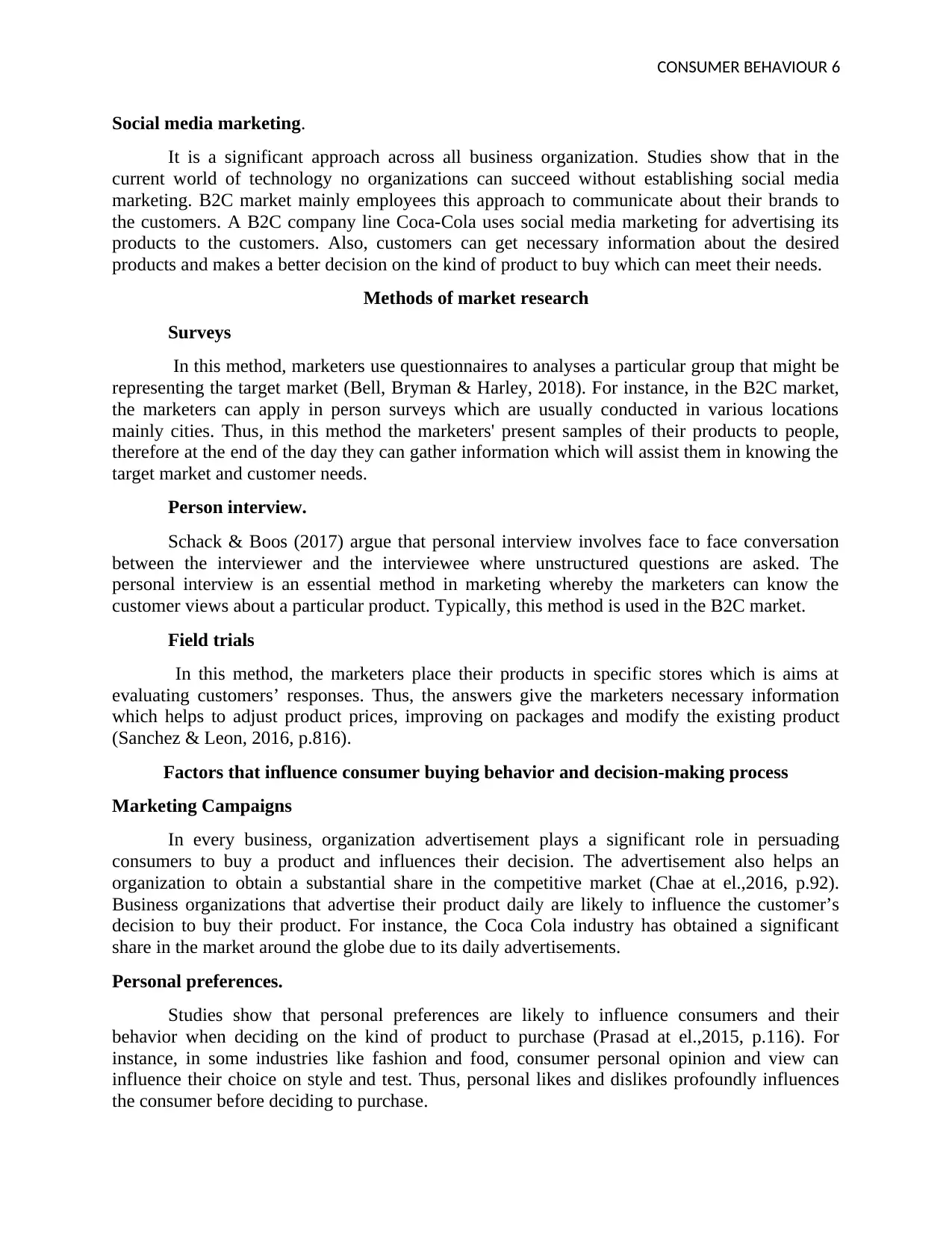
CONSUMER BEHAVIOUR 6
Social media marketing.
It is a significant approach across all business organization. Studies show that in the
current world of technology no organizations can succeed without establishing social media
marketing. B2C market mainly employees this approach to communicate about their brands to
the customers. A B2C company line Coca-Cola uses social media marketing for advertising its
products to the customers. Also, customers can get necessary information about the desired
products and makes a better decision on the kind of product to buy which can meet their needs.
Methods of market research
Surveys
In this method, marketers use questionnaires to analyses a particular group that might be
representing the target market (Bell, Bryman & Harley, 2018). For instance, in the B2C market,
the marketers can apply in person surveys which are usually conducted in various locations
mainly cities. Thus, in this method the marketers' present samples of their products to people,
therefore at the end of the day they can gather information which will assist them in knowing the
target market and customer needs.
Person interview.
Schack & Boos (2017) argue that personal interview involves face to face conversation
between the interviewer and the interviewee where unstructured questions are asked. The
personal interview is an essential method in marketing whereby the marketers can know the
customer views about a particular product. Typically, this method is used in the B2C market.
Field trials
In this method, the marketers place their products in specific stores which is aims at
evaluating customers’ responses. Thus, the answers give the marketers necessary information
which helps to adjust product prices, improving on packages and modify the existing product
(Sanchez & Leon, 2016, p.816).
Factors that influence consumer buying behavior and decision-making process
Marketing Campaigns
In every business, organization advertisement plays a significant role in persuading
consumers to buy a product and influences their decision. The advertisement also helps an
organization to obtain a substantial share in the competitive market (Chae at el.,2016, p.92).
Business organizations that advertise their product daily are likely to influence the customer’s
decision to buy their product. For instance, the Coca Cola industry has obtained a significant
share in the market around the globe due to its daily advertisements.
Personal preferences.
Studies show that personal preferences are likely to influence consumers and their
behavior when deciding on the kind of product to purchase (Prasad at el.,2015, p.116). For
instance, in some industries like fashion and food, consumer personal opinion and view can
influence their choice on style and test. Thus, personal likes and dislikes profoundly influences
the consumer before deciding to purchase.
Social media marketing.
It is a significant approach across all business organization. Studies show that in the
current world of technology no organizations can succeed without establishing social media
marketing. B2C market mainly employees this approach to communicate about their brands to
the customers. A B2C company line Coca-Cola uses social media marketing for advertising its
products to the customers. Also, customers can get necessary information about the desired
products and makes a better decision on the kind of product to buy which can meet their needs.
Methods of market research
Surveys
In this method, marketers use questionnaires to analyses a particular group that might be
representing the target market (Bell, Bryman & Harley, 2018). For instance, in the B2C market,
the marketers can apply in person surveys which are usually conducted in various locations
mainly cities. Thus, in this method the marketers' present samples of their products to people,
therefore at the end of the day they can gather information which will assist them in knowing the
target market and customer needs.
Person interview.
Schack & Boos (2017) argue that personal interview involves face to face conversation
between the interviewer and the interviewee where unstructured questions are asked. The
personal interview is an essential method in marketing whereby the marketers can know the
customer views about a particular product. Typically, this method is used in the B2C market.
Field trials
In this method, the marketers place their products in specific stores which is aims at
evaluating customers’ responses. Thus, the answers give the marketers necessary information
which helps to adjust product prices, improving on packages and modify the existing product
(Sanchez & Leon, 2016, p.816).
Factors that influence consumer buying behavior and decision-making process
Marketing Campaigns
In every business, organization advertisement plays a significant role in persuading
consumers to buy a product and influences their decision. The advertisement also helps an
organization to obtain a substantial share in the competitive market (Chae at el.,2016, p.92).
Business organizations that advertise their product daily are likely to influence the customer’s
decision to buy their product. For instance, the Coca Cola industry has obtained a significant
share in the market around the globe due to its daily advertisements.
Personal preferences.
Studies show that personal preferences are likely to influence consumers and their
behavior when deciding on the kind of product to purchase (Prasad at el.,2015, p.116). For
instance, in some industries like fashion and food, consumer personal opinion and view can
influence their choice on style and test. Thus, personal likes and dislikes profoundly influences
the consumer before deciding to purchase.
⊘ This is a preview!⊘
Do you want full access?
Subscribe today to unlock all pages.

Trusted by 1+ million students worldwide
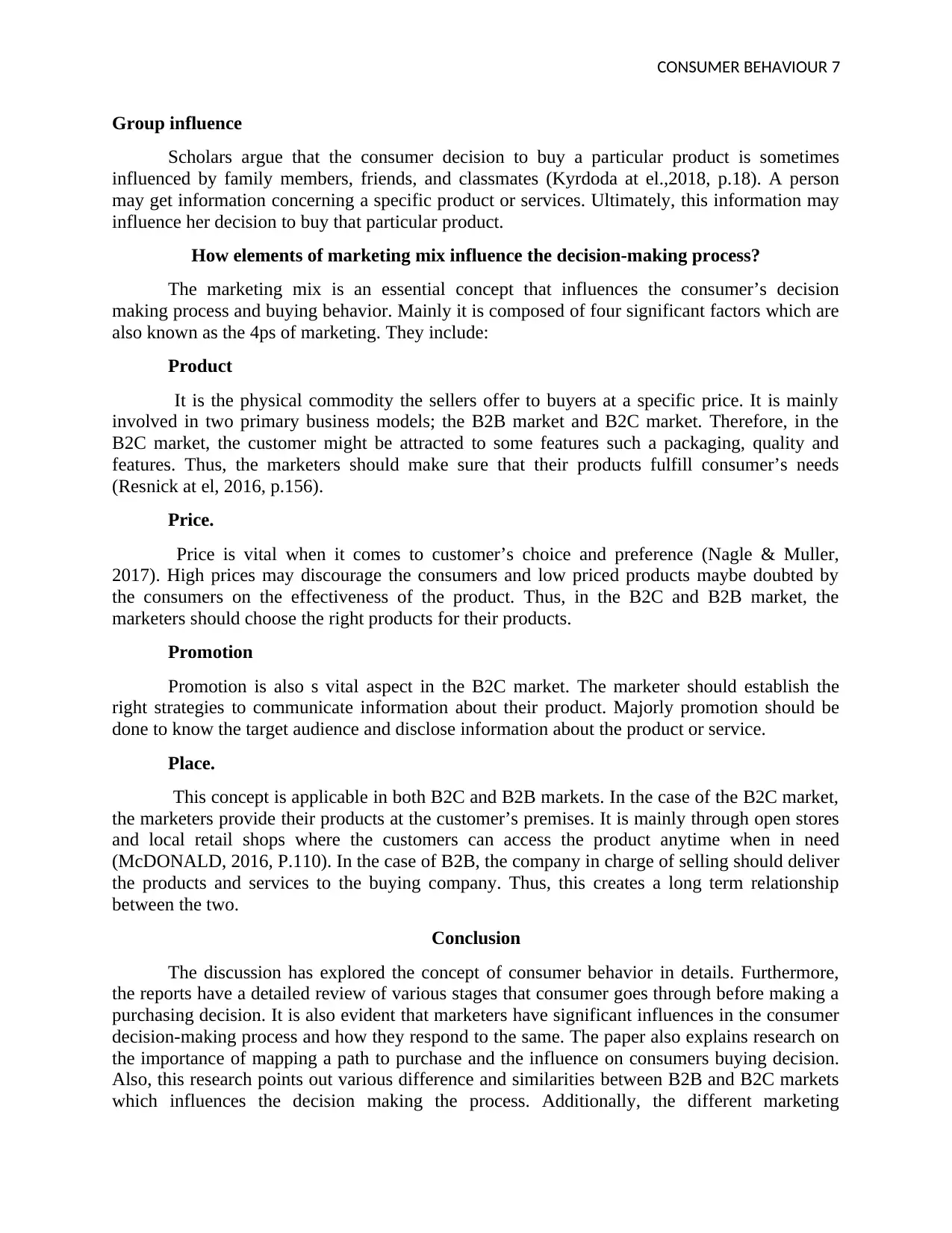
CONSUMER BEHAVIOUR 7
Group influence
Scholars argue that the consumer decision to buy a particular product is sometimes
influenced by family members, friends, and classmates (Kyrdoda at el.,2018, p.18). A person
may get information concerning a specific product or services. Ultimately, this information may
influence her decision to buy that particular product.
How elements of marketing mix influence the decision-making process?
The marketing mix is an essential concept that influences the consumer’s decision
making process and buying behavior. Mainly it is composed of four significant factors which are
also known as the 4ps of marketing. They include:
Product
It is the physical commodity the sellers offer to buyers at a specific price. It is mainly
involved in two primary business models; the B2B market and B2C market. Therefore, in the
B2C market, the customer might be attracted to some features such a packaging, quality and
features. Thus, the marketers should make sure that their products fulfill consumer’s needs
(Resnick at el, 2016, p.156).
Price.
Price is vital when it comes to customer’s choice and preference (Nagle & Muller,
2017). High prices may discourage the consumers and low priced products maybe doubted by
the consumers on the effectiveness of the product. Thus, in the B2C and B2B market, the
marketers should choose the right products for their products.
Promotion
Promotion is also s vital aspect in the B2C market. The marketer should establish the
right strategies to communicate information about their product. Majorly promotion should be
done to know the target audience and disclose information about the product or service.
Place.
This concept is applicable in both B2C and B2B markets. In the case of the B2C market,
the marketers provide their products at the customer’s premises. It is mainly through open stores
and local retail shops where the customers can access the product anytime when in need
(McDONALD, 2016, P.110). In the case of B2B, the company in charge of selling should deliver
the products and services to the buying company. Thus, this creates a long term relationship
between the two.
Conclusion
The discussion has explored the concept of consumer behavior in details. Furthermore,
the reports have a detailed review of various stages that consumer goes through before making a
purchasing decision. It is also evident that marketers have significant influences in the consumer
decision-making process and how they respond to the same. The paper also explains research on
the importance of mapping a path to purchase and the influence on consumers buying decision.
Also, this research points out various difference and similarities between B2B and B2C markets
which influences the decision making the process. Additionally, the different marketing
Group influence
Scholars argue that the consumer decision to buy a particular product is sometimes
influenced by family members, friends, and classmates (Kyrdoda at el.,2018, p.18). A person
may get information concerning a specific product or services. Ultimately, this information may
influence her decision to buy that particular product.
How elements of marketing mix influence the decision-making process?
The marketing mix is an essential concept that influences the consumer’s decision
making process and buying behavior. Mainly it is composed of four significant factors which are
also known as the 4ps of marketing. They include:
Product
It is the physical commodity the sellers offer to buyers at a specific price. It is mainly
involved in two primary business models; the B2B market and B2C market. Therefore, in the
B2C market, the customer might be attracted to some features such a packaging, quality and
features. Thus, the marketers should make sure that their products fulfill consumer’s needs
(Resnick at el, 2016, p.156).
Price.
Price is vital when it comes to customer’s choice and preference (Nagle & Muller,
2017). High prices may discourage the consumers and low priced products maybe doubted by
the consumers on the effectiveness of the product. Thus, in the B2C and B2B market, the
marketers should choose the right products for their products.
Promotion
Promotion is also s vital aspect in the B2C market. The marketer should establish the
right strategies to communicate information about their product. Majorly promotion should be
done to know the target audience and disclose information about the product or service.
Place.
This concept is applicable in both B2C and B2B markets. In the case of the B2C market,
the marketers provide their products at the customer’s premises. It is mainly through open stores
and local retail shops where the customers can access the product anytime when in need
(McDONALD, 2016, P.110). In the case of B2B, the company in charge of selling should deliver
the products and services to the buying company. Thus, this creates a long term relationship
between the two.
Conclusion
The discussion has explored the concept of consumer behavior in details. Furthermore,
the reports have a detailed review of various stages that consumer goes through before making a
purchasing decision. It is also evident that marketers have significant influences in the consumer
decision-making process and how they respond to the same. The paper also explains research on
the importance of mapping a path to purchase and the influence on consumers buying decision.
Also, this research points out various difference and similarities between B2B and B2C markets
which influences the decision making the process. Additionally, the different marketing
Paraphrase This Document
Need a fresh take? Get an instant paraphrase of this document with our AI Paraphraser
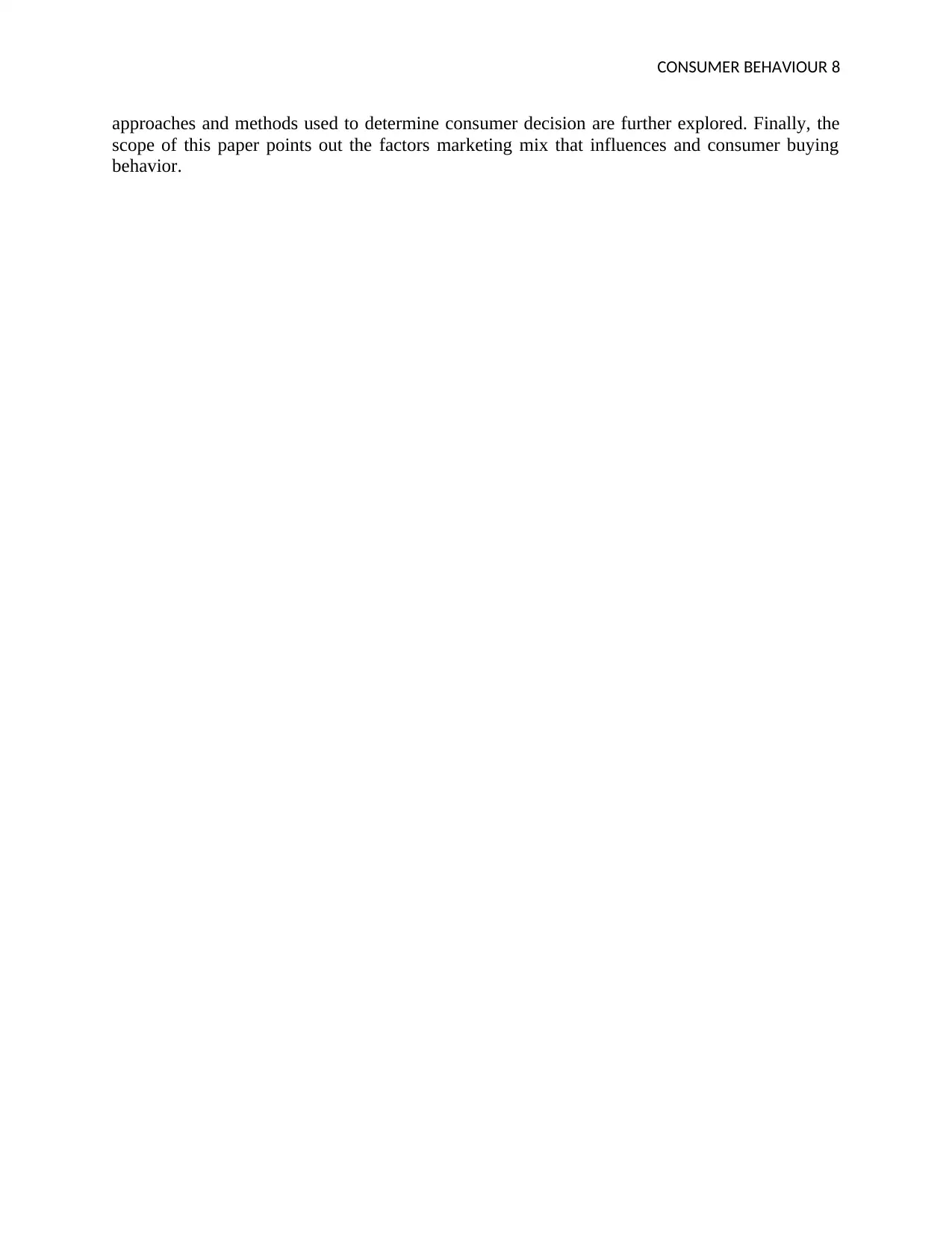
CONSUMER BEHAVIOUR 8
approaches and methods used to determine consumer decision are further explored. Finally, the
scope of this paper points out the factors marketing mix that influences and consumer buying
behavior.
approaches and methods used to determine consumer decision are further explored. Finally, the
scope of this paper points out the factors marketing mix that influences and consumer buying
behavior.
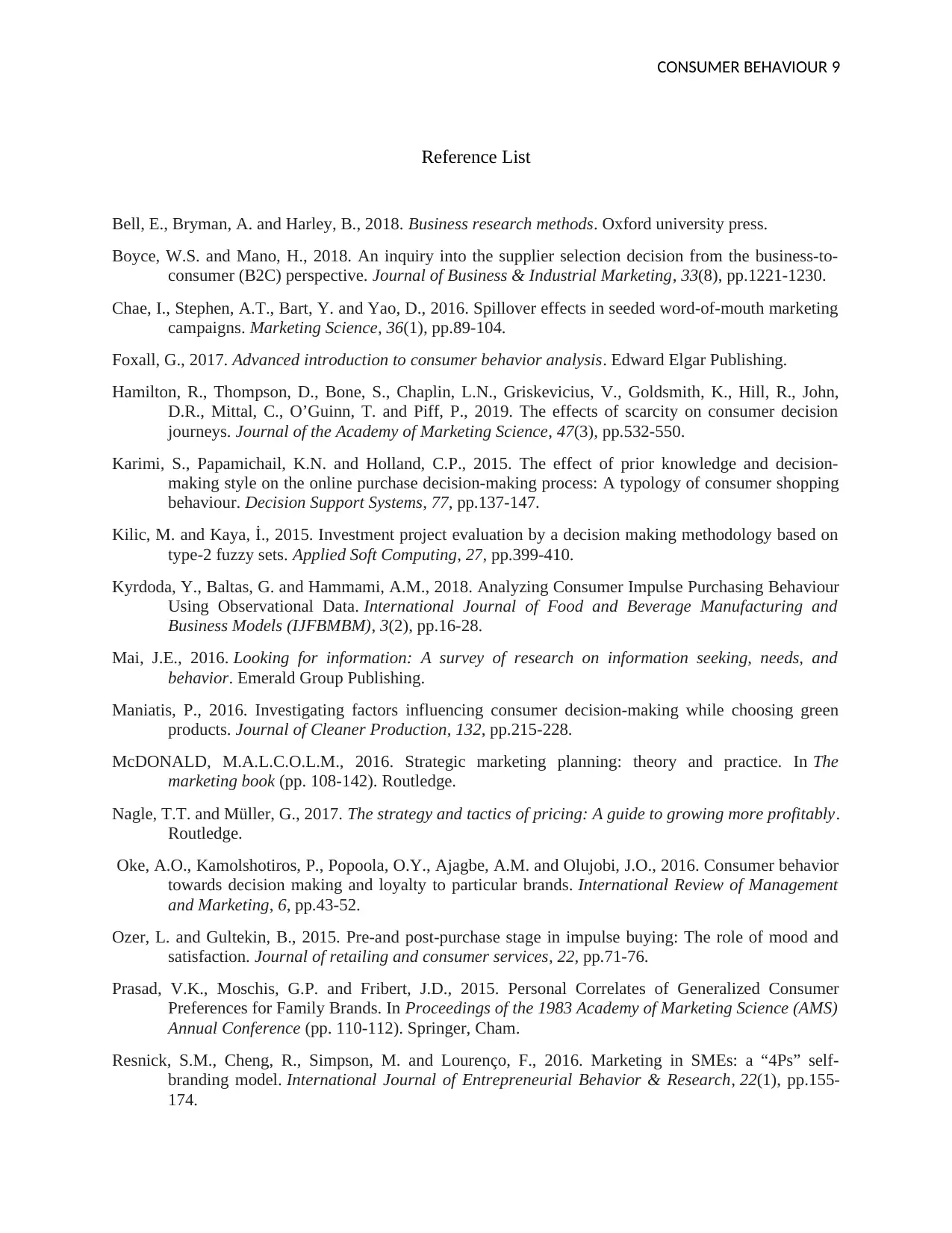
CONSUMER BEHAVIOUR 9
Reference List
Bell, E., Bryman, A. and Harley, B., 2018. Business research methods. Oxford university press.
Boyce, W.S. and Mano, H., 2018. An inquiry into the supplier selection decision from the business-to-
consumer (B2C) perspective. Journal of Business & Industrial Marketing, 33(8), pp.1221-1230.
Chae, I., Stephen, A.T., Bart, Y. and Yao, D., 2016. Spillover effects in seeded word-of-mouth marketing
campaigns. Marketing Science, 36(1), pp.89-104.
Foxall, G., 2017. Advanced introduction to consumer behavior analysis. Edward Elgar Publishing.
Hamilton, R., Thompson, D., Bone, S., Chaplin, L.N., Griskevicius, V., Goldsmith, K., Hill, R., John,
D.R., Mittal, C., O’Guinn, T. and Piff, P., 2019. The effects of scarcity on consumer decision
journeys. Journal of the Academy of Marketing Science, 47(3), pp.532-550.
Karimi, S., Papamichail, K.N. and Holland, C.P., 2015. The effect of prior knowledge and decision-
making style on the online purchase decision-making process: A typology of consumer shopping
behaviour. Decision Support Systems, 77, pp.137-147.
Kilic, M. and Kaya, İ., 2015. Investment project evaluation by a decision making methodology based on
type-2 fuzzy sets. Applied Soft Computing, 27, pp.399-410.
Kyrdoda, Y., Baltas, G. and Hammami, A.M., 2018. Analyzing Consumer Impulse Purchasing Behaviour
Using Observational Data. International Journal of Food and Beverage Manufacturing and
Business Models (IJFBMBM), 3(2), pp.16-28.
Mai, J.E., 2016. Looking for information: A survey of research on information seeking, needs, and
behavior. Emerald Group Publishing.
Maniatis, P., 2016. Investigating factors influencing consumer decision-making while choosing green
products. Journal of Cleaner Production, 132, pp.215-228.
McDONALD, M.A.L.C.O.L.M., 2016. Strategic marketing planning: theory and practice. In The
marketing book (pp. 108-142). Routledge.
Nagle, T.T. and Müller, G., 2017. The strategy and tactics of pricing: A guide to growing more profitably.
Routledge.
Oke, A.O., Kamolshotiros, P., Popoola, O.Y., Ajagbe, A.M. and Olujobi, J.O., 2016. Consumer behavior
towards decision making and loyalty to particular brands. International Review of Management
and Marketing, 6, pp.43-52.
Ozer, L. and Gultekin, B., 2015. Pre-and post-purchase stage in impulse buying: The role of mood and
satisfaction. Journal of retailing and consumer services, 22, pp.71-76.
Prasad, V.K., Moschis, G.P. and Fribert, J.D., 2015. Personal Correlates of Generalized Consumer
Preferences for Family Brands. In Proceedings of the 1983 Academy of Marketing Science (AMS)
Annual Conference (pp. 110-112). Springer, Cham.
Resnick, S.M., Cheng, R., Simpson, M. and Lourenço, F., 2016. Marketing in SMEs: a “4Ps” self-
branding model. International Journal of Entrepreneurial Behavior & Research, 22(1), pp.155-
174.
Reference List
Bell, E., Bryman, A. and Harley, B., 2018. Business research methods. Oxford university press.
Boyce, W.S. and Mano, H., 2018. An inquiry into the supplier selection decision from the business-to-
consumer (B2C) perspective. Journal of Business & Industrial Marketing, 33(8), pp.1221-1230.
Chae, I., Stephen, A.T., Bart, Y. and Yao, D., 2016. Spillover effects in seeded word-of-mouth marketing
campaigns. Marketing Science, 36(1), pp.89-104.
Foxall, G., 2017. Advanced introduction to consumer behavior analysis. Edward Elgar Publishing.
Hamilton, R., Thompson, D., Bone, S., Chaplin, L.N., Griskevicius, V., Goldsmith, K., Hill, R., John,
D.R., Mittal, C., O’Guinn, T. and Piff, P., 2019. The effects of scarcity on consumer decision
journeys. Journal of the Academy of Marketing Science, 47(3), pp.532-550.
Karimi, S., Papamichail, K.N. and Holland, C.P., 2015. The effect of prior knowledge and decision-
making style on the online purchase decision-making process: A typology of consumer shopping
behaviour. Decision Support Systems, 77, pp.137-147.
Kilic, M. and Kaya, İ., 2015. Investment project evaluation by a decision making methodology based on
type-2 fuzzy sets. Applied Soft Computing, 27, pp.399-410.
Kyrdoda, Y., Baltas, G. and Hammami, A.M., 2018. Analyzing Consumer Impulse Purchasing Behaviour
Using Observational Data. International Journal of Food and Beverage Manufacturing and
Business Models (IJFBMBM), 3(2), pp.16-28.
Mai, J.E., 2016. Looking for information: A survey of research on information seeking, needs, and
behavior. Emerald Group Publishing.
Maniatis, P., 2016. Investigating factors influencing consumer decision-making while choosing green
products. Journal of Cleaner Production, 132, pp.215-228.
McDONALD, M.A.L.C.O.L.M., 2016. Strategic marketing planning: theory and practice. In The
marketing book (pp. 108-142). Routledge.
Nagle, T.T. and Müller, G., 2017. The strategy and tactics of pricing: A guide to growing more profitably.
Routledge.
Oke, A.O., Kamolshotiros, P., Popoola, O.Y., Ajagbe, A.M. and Olujobi, J.O., 2016. Consumer behavior
towards decision making and loyalty to particular brands. International Review of Management
and Marketing, 6, pp.43-52.
Ozer, L. and Gultekin, B., 2015. Pre-and post-purchase stage in impulse buying: The role of mood and
satisfaction. Journal of retailing and consumer services, 22, pp.71-76.
Prasad, V.K., Moschis, G.P. and Fribert, J.D., 2015. Personal Correlates of Generalized Consumer
Preferences for Family Brands. In Proceedings of the 1983 Academy of Marketing Science (AMS)
Annual Conference (pp. 110-112). Springer, Cham.
Resnick, S.M., Cheng, R., Simpson, M. and Lourenço, F., 2016. Marketing in SMEs: a “4Ps” self-
branding model. International Journal of Entrepreneurial Behavior & Research, 22(1), pp.155-
174.
⊘ This is a preview!⊘
Do you want full access?
Subscribe today to unlock all pages.

Trusted by 1+ million students worldwide
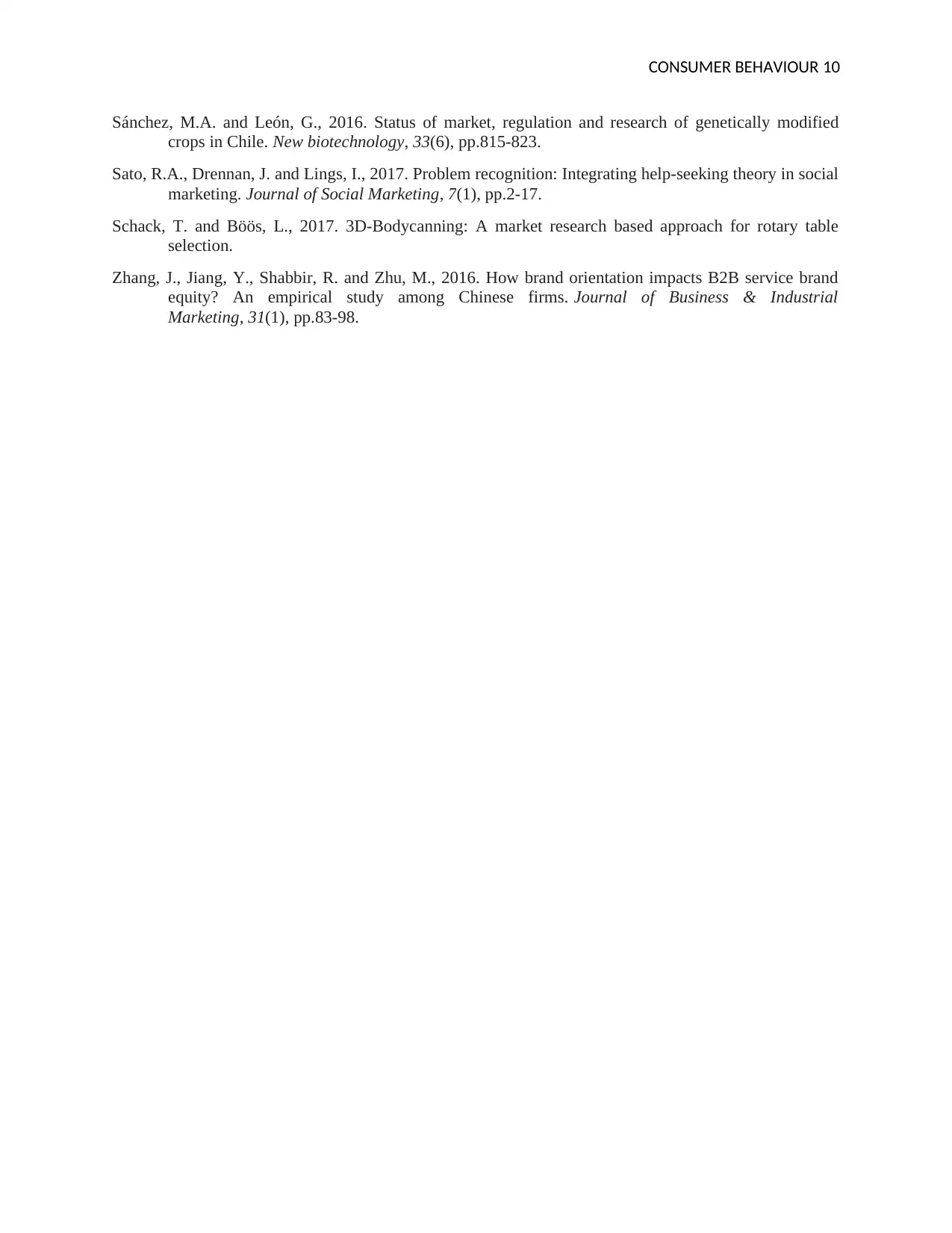
CONSUMER BEHAVIOUR 10
Sánchez, M.A. and León, G., 2016. Status of market, regulation and research of genetically modified
crops in Chile. New biotechnology, 33(6), pp.815-823.
Sato, R.A., Drennan, J. and Lings, I., 2017. Problem recognition: Integrating help-seeking theory in social
marketing. Journal of Social Marketing, 7(1), pp.2-17.
Schack, T. and Böös, L., 2017. 3D-Bodycanning: A market research based approach for rotary table
selection.
Zhang, J., Jiang, Y., Shabbir, R. and Zhu, M., 2016. How brand orientation impacts B2B service brand
equity? An empirical study among Chinese firms. Journal of Business & Industrial
Marketing, 31(1), pp.83-98.
Sánchez, M.A. and León, G., 2016. Status of market, regulation and research of genetically modified
crops in Chile. New biotechnology, 33(6), pp.815-823.
Sato, R.A., Drennan, J. and Lings, I., 2017. Problem recognition: Integrating help-seeking theory in social
marketing. Journal of Social Marketing, 7(1), pp.2-17.
Schack, T. and Böös, L., 2017. 3D-Bodycanning: A market research based approach for rotary table
selection.
Zhang, J., Jiang, Y., Shabbir, R. and Zhu, M., 2016. How brand orientation impacts B2B service brand
equity? An empirical study among Chinese firms. Journal of Business & Industrial
Marketing, 31(1), pp.83-98.
1 out of 10
Related Documents
Your All-in-One AI-Powered Toolkit for Academic Success.
+13062052269
info@desklib.com
Available 24*7 on WhatsApp / Email
![[object Object]](/_next/static/media/star-bottom.7253800d.svg)
Unlock your academic potential
Copyright © 2020–2025 A2Z Services. All Rights Reserved. Developed and managed by ZUCOL.




